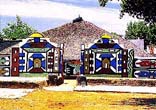 |
Ndebele tribe of africa
|
 |
| Murals: |
 |
Ndebele homes are painted with bright colors: pinks, blues, yellow, oranges, and greenes. Bold colorful designs are specific to a family and it is up to the women to design and paint them with the children. |
 |
Enclosures are a sign of wealth as they keep in animals owned by the family. | |
 |
The village has a main meeting hall used for meeting with visitors or for celebrations like weddings. | |
| Mural links: | Beloit, South Africa - a visual tour | |
| Benjamin McKendall, photographer | ||
| Painted houses | ||
| Ndebele architecture | ||
| Clothing: |
 |
Igabe, a fringed apron worn by children with a beaded waistband featuring a design of triangles often used on these aprons. Dennilton 1982 |
 |
Isiphephetu, a young woman's apron. This example is made of stiffened canvas. The beaded motifs include the letter M for Middleburg, a town in the Ndebele area, and a plant form, a possible reference to hopes for a good harvest. Dennilton 1981. Photo C. Booth | |
 |
These bead leggings can protect the legs when running through dry grasses while being a fashion statement. | |
| Clothing links: | Unique art |
| Beadwork: | Colors used in Ndebele artwork have cultural meaning. Designs can be read like a newspaper headline when you understand the code: |  |
|
Finding a spouse is maybe the most difficult thing for people to do. In many traditional societies, marriages were arranged by parents or other elders. Sometimes the young people involved could turn down a marriage they did not want, but other times the couple had no choice at all. Most if not all cultures have kind of symbol system to show whether a person is married or single. In Canada, most common is the use of wedding and engagement rings. Among traditional Mennonites, if a door is painted green, it means there is a daughter eligible for marriage. The Zulu people of southern Africa developed a complex code using coloured beads. In Zulu tradition adulthood comes with marriage, and married people have advantages over those who are not. This created a major incentive for young men to gather enough wealth to purchase what was required as marriage goods. Traditional wealth was measured in cattle, and only a man with enough cattle could afford to marry. Young girls learned bead work and the meaning of the symbols and colours used from their older sisters. The bead work was usually worn as a head or neck band. Men depended on female relatives to explain the code. They can see whether a woman is engaged, married, unmarried, has children or unmarried sisters. The patterns and colours can also tell what region a woman comes from and what her social standing is. The one basic geometric shape used for this kind of bead work is the triangle and a maximum of seven colours. The three corners of the triangle represent the family: mother, father and child. The point of the triangle is facing down is the symbol for an unmarried man or boy, while a triangle with the point facing up is the symbol for an unmarried woman or girl. A married man is symbolized by two triangles joined at the point forming an hourglass shape. A married woman is shown by two triangles joined at the base making a diamond shape. The seven colours used are black, blue, yellow, green, pink, red and white. Each colour has two meanings, one positive, one negative, except white. White has only one meaning, purity and spiritual love. When another colour is used beside white, it takes its positive meaning. For example, a blue band with a band signifies "fidelity" or "faithful". This colour combination is commonly used to show if someone is engaged. Blue, white and black bands are a standard combination to show marriage. A Zulu valentine, called an Ibheqe, is a narrow beaded band with a rectangular flap that rests in the hollow of the throat when worn around the neck. The flap shows the design made up of triangles in various combinations. One example might be White, Red, Blue. The red beside the white could be read as "I love you". The blue band in this case, would mean "request", that is asking for answer. Beside the white/red combination, it would ask "Will you be my valentine?" A boy would use the girl symbol (triangle pointing up). |
| Bead Links: | Ndebele beadwork |
|
Alex
Kent ©
2007
|